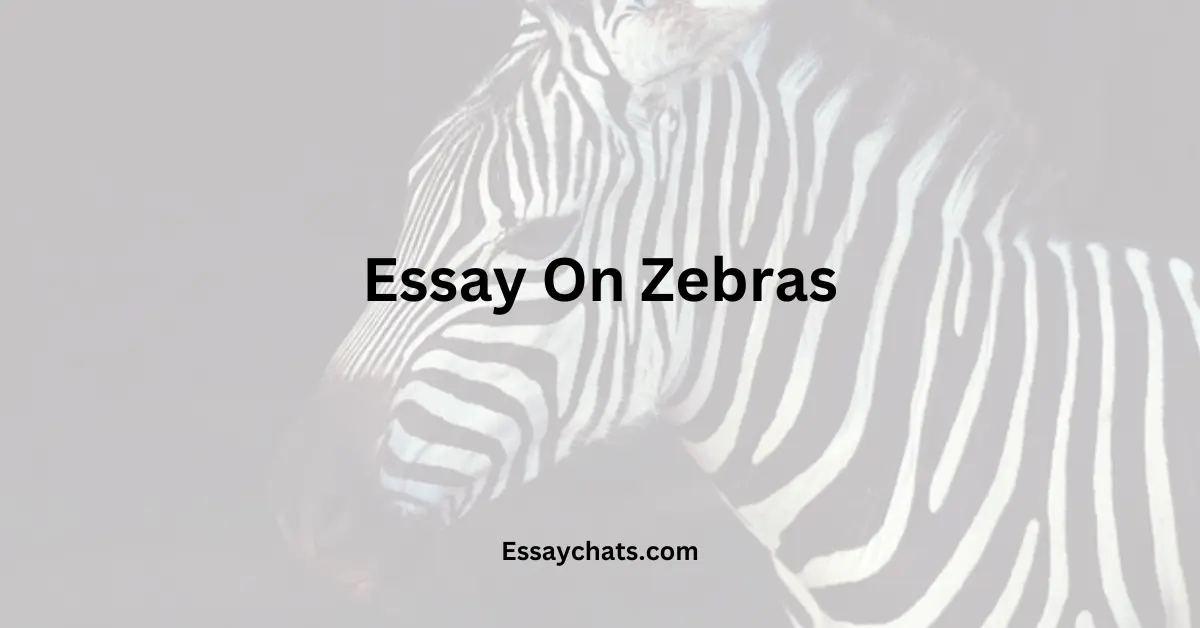Introduction
Zebras, the charismatic creatures of the African grasslands, have captured the fascination of people around the world. With their distinct black and white striped coats, zebras possess a charm that sets them apart from other animals. This Essay On Zebras will dive into the mesmerizing appearance, unique habitat, social behavior, feeding habits, predators and defense mechanisms, and the crucial conservation efforts surrounding these remarkable animals.
Essay On Zebras
A. The Intriguing Black and White Stripes
Their distinguishing feature is the fascinating black and white stripes adorning zebras’ bodies. These patterns make zebras instantly recognizable and vital to their survival. The stripes act as a natural camouflage, allowing zebras to blend seamlessly into the grasslands and confuse potential predators.
B. Unique Patterns and Individual Identification
It is fascinating to note that each zebra possesses a distinctive pattern of stripes, much like human fingerprints. These patterns vary from zebra to zebra, enabling scientists and researchers to identify and track individuals within herds. This remarkable characteristic contributes to understanding zebra behavior, migration patterns, and population dynamics.
Zebras’ Habitat and Range
A. Thriving in the African Grasslands and Savannahs
Zebras are well adapted to the vast grasslands and savannahs across Africa. These magnificent creatures are primarily found in countries such as Kenya, Tanzania, Botswana, and South Africa. The grassy terrain provides them with ample food sources and an ideal habitat for survival.
B. Migration and Adaptation to Changing Environments
Zebras are known for their remarkable ability to migrate for food and water. These seasonal movements often require them to travel long distances, showcasing their endurance and adaptability. Migration allows zebras to explore new territories and escape harsh conditions, ensuring their survival in ever-changing environments.
The Social Lives of Zebras
A. Living in Herds: Strength in Numbers
Zebras are highly social animals, forming cohesive herds consisting of multiple individuals. These herds serve as a crucial defense mechanism against predators. By staying together, zebras increase their chances of survival, as there are more eyes to spot danger and more bodies to deter potential threats.
B. Leadership and Hierarchy within the Herd
Within a zebra herd, a dominant male, known as a stallion, leads the group. The stallion guides the herd to food and water sources and protects them from predators. Other herd members, including mares and foals, establish a social hierarchy based on their age and status within the group. This hierarchical structure helps maintain order and ensures the efficient functioning of the herd.
Zebras’ Feeding Habits
A. Herbivores of the Savannah
Zebras are herbivorous animals, meaning their diet consists solely of plants. They predominantly feed on grass and other vegetation found in the savannah. Their unique digestive system is specially adapted to extract nutrients from tough and fibrous grasses, enabling them to thrive in their grassland habitat.
B. Grazing Techniques and Adaptations
Zebras employ various grazing techniques to efficiently feed on grasses. They use their strong and sharp teeth to bite off the blades of grass close to the ground. Zebras also have an excellent sense of smell, which helps them locate new grazing areas from a considerable distance. Their ability to extract nutrients from vegetation allows them to sustain their energy levels and well-being.
Zebras’ Predators and Defense Mechanisms
A. A Constant Battle for Survival
Zebras face a range of predators in their natural habitat. Lions, hyenas, and crocodiles are among the most prominent threats. These predators rely on their strength and hunting skills to target zebras, often singling out the young and weak members of the herd. The survival of zebras depends on their ability to evade and defend against these formidable predators.
B. Uniting against Threats: The Power of the Herd
When confronted by a predator, zebras showcase unique defense mechanisms. They gather together, forming a tight circle with the young and vulnerable individuals protected at the center. This formation presents a united front, making it challenging for predators to target a specific zebra. Zebras kick and bite with their powerful legs, using them both for defense and establishing their dominance within the herd.
Conservation Efforts for Zebras
A. Protecting Their Natural Habitat
Like many other wildlife species, zebras face various threats to their survival. One of the most significant challenges is habitat destruction due to human activities such as deforestation and land conversion. To safeguard zebras and their natural habitat, conservation organizations, and governments work to establish protected areas, national parks, and reserves. These efforts ensure the preservation of the grasslands and savannahs that zebras rely on for food and shelter.
B. Raising Awareness and Combating Threats
Educating the public about the importance of zebra conservation plays a crucial role in their survival. Conservationists and researchers conduct studies and raise awareness about the ecological significance of zebras and their role in maintaining a balanced ecosystem. By highlighting the threats they face, such as poaching and illegal hunting, efforts can be made to combat these activities through stricter regulations, enforcement, and community engagement.
Conclusion
This Essay On Zebras concludes that magnificent creatures with unique black and white stripes, adapted to thrive in African grasslands and savannahs. Their social nature, feeding habits, defense mechanisms, and ongoing conservation efforts make them truly remarkable. By appreciating the beauty and understanding the importance of zebras, we can contribute to their preservation and secure a future where these enigmatic animals continue to roam freely in the wild. Let us stand as guardians of their habitat and advocate for their protection, ensuring that zebras continue to grace our planet for generations.
Also Check Out:
